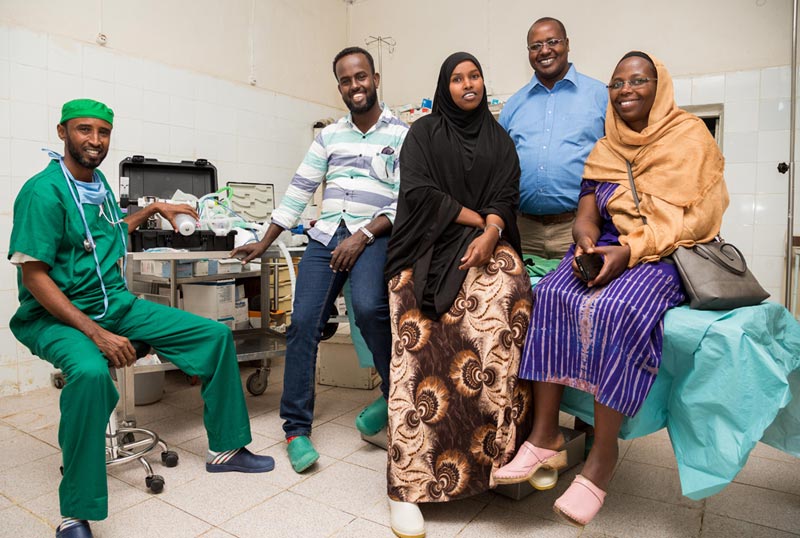Many visitors, and even residents, think that North Devon is simply a beautiful place to visit and relax in, unaware of the extent of industry here. Business Action is keen to highlight what businesses, especially manufacturers, are achieving, particularly in terms of exports. Diamedica not only manufactures and exports from North Devon to 70 countries across the world, but is also playing an influential role in improving health and medicine in developing countries. The company’s Andrea Charters details below its SANSOM project in Somaliland.

Partnerships for progress
by Andrea Charters
After the call for prayer that rang out over Hargeisa had fallen silent, a group of very special individuals gathered together at the Edna Adan Teaching Hospital. It was the start of the first ever Safe Anaesthesia for Somaliland Conference, or SANSOM project, where around 30 newly-trained nurse anaesthetists met together for three days of refresher training, and to share the challenges of their recent professional experiences.
SANSOM is a project initiated by North-Devon based Diamedica UK Ltd, a company that specialises in making medical equipment for challenging environments. Its aim was to equip newly qualified anaesthesia providers with kits of appropriate equipment. The project marks the start of a new and vital healthcare framework designed to support nurse anaesthetists and is unique because in addition to ongoing training and support, the collection of anaesthesia data is central to it – and this is a first for Somaliland.
From now on anaesthetists will record patient details before, during and after their operations – from their vital signs of life statistics (BT, BP, HR, and RR) through to recovery time or, if appropriate, time and cause of death following a procedure. This will serve as an important aid for reviewing, modifying and ultimately improving anaesthetists’ performance.
Training director Dr Mark Newton and his team from Kijabe Hospital in Kenya had trained the nurse anaesthetists who attended over a two-year period and aimed to assess, update and build on students’ progress.
One workshop run by Dr Newton involved a simulation exercise with a Laerdal manikin, whose vital signs he controlled from a laptop, unseen behind a dark screen.
While initially the surprised students who entered the room one at a time were dubious about the plastic baby on the operating table, it didn’t take long before the wailing patient monitor prompted the first student to call for the help of a colleague, who was then briefed on the patient’s condition.
With Dr Newton in charge of the ‘baby’s’ rapid deterioration, the atmosphere in the room grew tense, with one student administering an adrenalin injection, another beginning CPR.
Ultimately the tiny patient ‘died’ on the theatre table, giving rise to a post-op review between Dr Newton and the students concerned. One team of anaesthetists had to be repeatedly asked to stop giving CPR – the simulation was over, yet it seemed so real to them. Students were plainly engaged and inspired, and the feedback given about this session was excellent.
Other workshops were run by training leaders Hosea Cheruiyot and Mary Mungai, Gatwiri Murithi and Joash Kiptanui – all from Kijabe Hospital. Content was hard-hitting and topical, with lectures covering management of a range of obstetric complications and neonatal emergencies.
Students were also given workshops in the use of the electronic tablets they’d been given for data collection. Interestingly, these tablets were also programmed to serve as anaesthesia libraries and were enthusiastically received by students as a fantastic resource.
In addition to the contributions from the Kenya team, Diamedica’s director Robert Neighbour talked students through the care and maintenance of equipment donated by numerous charities including Safe Anaesthesia Worldwide and the DAK Foundation. His expertise in the donated DPA02 portable anaesthesia machines was important to ensure students were confident in their use and upkeep. Robert also delivered a short course in the use of Lifebox’s pulse oximeters.
The conclusion of the three-day conference saw the start of hundreds of miles of road trips across Somaliland to deliver anaesthesia and other related medical equipment to eight different government hospitals.
Dr Edna Adan herself led a convoy of four trucks to Hargeisa Group Hospital, Berbera Regional Hospital, Borama Regional Hospital, Burao General Hospital, Gabiley General Hospital and Sheikh District Hospital, and also hospitals in both Lasanod, Erigavo, and Gargaar Hospital.
Those involved in the delivery and installation of the equipment were met with a growing sense of optimism that a corner in Somaliland’s healthcare provision was being turned. With one of the highest rates of maternal and child mortality in the world, and with the majority of the population living in isolated, rural areas of the country, the SANSOM project addressed these issues head-on.
It’s important to note that the portable nature of the DPA02 anaesthesia machines means that while they are a vital hospital resource, they can easily be transported for outreach work.
Essentially, the SANSOM project will help to increase Somaliland’s surgical life saving capacity.
Now all we need to ensure is that this provision continues to grow.
SANSOM trainers and nurse anaesthetists are delighted with the delivery of Diamedica’s DPA02 anaesthesia machine.
For more details of Diamedica, visit diamedica.co.uk.


